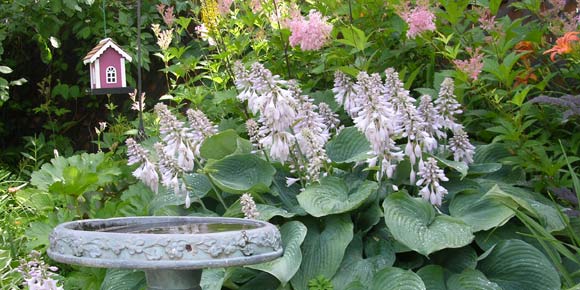One of the most eye-catching flowers in the garden belongs to the genus Filipendula, much admired for its stately form and outstanding flowers.
Filipendula is native to the Northern Hemisphere in a genus of about 12 perennials. It is especially known for its billows of delicate flowers that grow in clusters of white and gold and in clouds of pink that look like cotton candy. Some varieties can grow to eight feet.
Filipendula spreads slowly by underground rhizomes as well as by seed. It typically likes moisture and some shade.
These are hardy plants that are seldom attacked by bugs or mildew.
Well-known species include meadowsweet
(F. ulmaria) and dropwort (F. vulgaris), both native to Europe, and queen-of-the-prairies (F. rubra), native to North America.
Meadowsweet. F. ulmaria, commonly known as meadowsweet and sometimes called queen-of-the-meadow, is a well-behaved plant with maple-leaf-shaped, deeply-toothed, corrugated leaves. It sends up creamy umbels of flowers on sturdy stems.
Meadowsweet was one of the three most sacred herbs of the Druids and was used in medicinally in many ways, mainly as an astringent, anti-inflammatory, diruetic and stomach aid. It is the base plant that was used by Felix Hoffman, an employee of Bayer AG
to make aspirin (Acetylsalic acid) because it was easier on the stomach than pure salicylic acid. The word
aspirin came for the plant’s old botanical name, Spiraea ulmaria.
The young leaves have a pleasant taste and have been used to flavour soups and, when dried, as a sweetener in herbal teas. The flowers are used in alcoholic beverages and in stewed fruits. The leaves
continue to be attractive if properly watered and add texture to the garden after flowering.
Fern-leaf dropwort. F. vulgaris, fernleaf dropwort (to distinguish it from water dropwort), has tiny flowers that can begin pink, open to white and appear in dense clusters with a ferny texture. Roots have a scent of oil of wintergreen.
This is a lovely plant that will grace any garden in June with its foamy flowers and deep green, ferny leaves.
This plant prefers partial shade. It is more tolerant of dry conditions than most other members of its genus, but does best in moist soil. The leaves have been used in times of famine as an addtion to soups and salads.
Queen-of-the-prairie. F. rubra ‘Venusta’, commonly known as queen-of-the-prairie (or Martha Washinton’s plume in the U.S.), is a stunning plant, whose large, pink, candy floss flowers rise as much as eight fee above deeply lobed, maple shaped leaves. The attractive seed heads can be left in place after they finished blooming in mid summer.
It needs moisture and will tolerate shade to partial shade or exposure to sun only in the cooler hours of the day. It does not tolerate drought.



